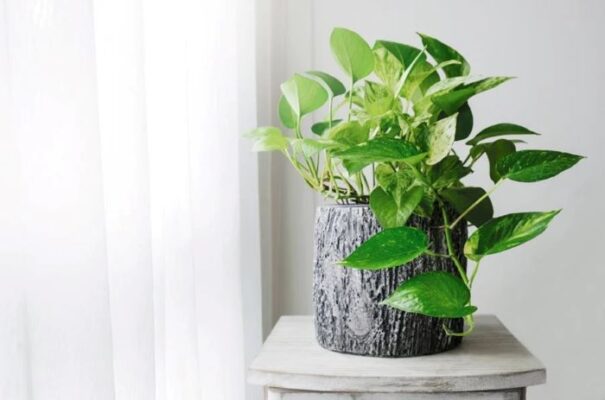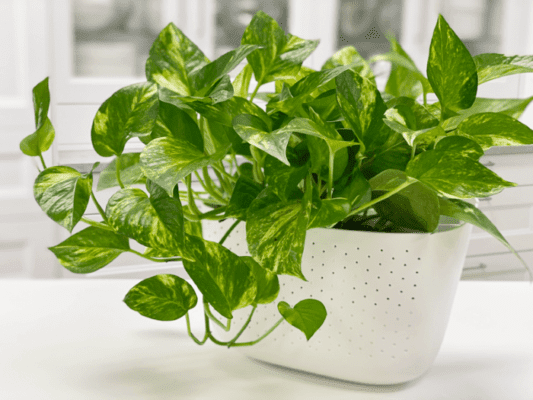With their trailing vines and colorful variegated leaves, pothos plants make excellent low-maintenance houseplants. As one of the easiest indoor plants to grow, pothos is popular for filling hanging baskets as well as climbing up supports to create a living green curtain in any room. Follow this complete pothos plant care guide for tips on watering, lighting, propagation, and more to keep your pothos vine happy and healthy indoors. In this article we talk about Pothos Plant Care – Best Tips for a Healthy and Lush Indoor Vine.
Table of Contents
Choosing a Pothos Variety

There are several different varieties of pothos to choose from. The most common is the golden pothos, Epipremnum aureum, with its golden green leaves. Other varieties have variegated leaves featuring white, yellow, or other shades blended with green. Some options include:
- Marble Queen – white and green variegated leaves
- Neon – bright lime green leaves
- Pearls and Jade – smaller green and white variegated leaves
- Manjula – shades of white, green, and yellow
When selecting a pothos, look for plants with plenty of healthy vines and no brown spots or yellowing on the leaves. The long vining stems make pothos perfect for hanging or climbing.
Light Requirements
Pothos prefer bright, indirect light indoors. A north or east-facing window is often ideal. Direct hot sunlight will scorch the leaves, causing brown spots or crispy edges. If the light is too low, the leaves can turn solid green and growth will slow. Adjust the placement if needed until the pothos receives consistent bright light without direct sun shining on it. Grow lights also work well for providing the right amount of light.
Watering Your Pothos Vine
Check the soil moisture before watering, as too much water is worse than too little for these tropical vines. Allow the top inch or two of soil to dry out between waterings. The leaves will start to curl, droop, or yellow if the plant needs water. After watering thoroughly, allow excess moisture to drain fully from the pot.
Use room temperature water, as cold water straight from the tap can shock the roots. In winter when indoor air is extremely dry, you may need to water more often, while hot summer months require less frequent watering. Always pour off any water that collects in the saucer beneath the pot after 30 minutes.
Temperature and Humidity
Pothos enjoy the same temperatures we do, between 60°F to 80°F. Keep them away from cold drafts from windows or hot air vents to maintain an even temperature. These tropical plants also appreciate moderate humidity. Place the pot on a pebble tray filled with water, mist the leaves, or use a humidifier to provide 40-50% relative humidity in the room.
Fertilizer
While pothos grow well in average room conditions, they will become more lush and full when fertilized. Use a balanced houseplant fertilizer diluted to half strength every two weeks in spring and summer. Discontinue feeding over winter when growth naturally slows.
Repotting Your Pothos
Repot pothos every couple years in early spring as needed. Carefully remove the root ball and loosen any circling roots before placing it in a container just one or two sizes larger. Use a general potting mix amended with perlite for drainage. After repotting, avoid fertilizing for a month while the roots establish.
Pruning and Shaping Your Pothos Vine
To maintain its vining habit, prune back long leggy stems or full plants as needed to promote bushier new growth. Snip stems back to just above a node, where new leaves emerge. Remove any leaves or vines that are fully yellowed, browned, or dying to keep your plant looking its best.
You can prune pothos to create any shape you desire. To train it climb a support, use plant velcro or soft ties to gently attach the vines against the support without damaging the stems.
Propagating Pothos Plants
One of the easiest houseplants to propagate, pothos can be grown from stem cuttings placed in water or potting mix. To grow in water, simply place a 6 inch stem cutting with a few leaves into a vase. Roots will sprout in a few weeks. For soil propagation, insert several nodes deep into the potting mix, keeping a few leaves above the surface. Keep the cutting or soil moist until new growth emerges.
Once the new plant is established, transplant water-rooted cuttings into potting soil. The new baby pothos can stay attached to the parent plant while continuing to grow until you’re ready to cut and repot it. This easy propagation method lets you create new pothos for your home or to give as gifts.
Common Pothos Problems
When provided with the proper care, pothos vines stay healthy and pest-free. But they can develop a few issues if conditions are not ideal. Here are some common pothos problems and how to fix them:
Yellow leaves – Usually due to overwatering or insufficient light. Allow soil to dry before watering again. Move plant to a brighter location if needed.
Brown leaf tips or edges – Caused by dry air or inconsistent watering. Increase humidity around the plant and keep soil moisture even.
Leggy growth with few leaves – Not enough light. Place in a brighter location and prune back long vines.
Slow growth – May need more fertilizer and bright light during active growing seasons.
Leaf spots or curling – Can indicate a pest problem. Check undersides of leaves and stems for signs of insects. Wipe leaves with insecticidal soap if found.
With the simple care outlined above, a pothos houseplant will thrive for many years. The vining stems can grow quite lengthy in ideal conditions, cascading 8 feet or longer from hanging baskets. Trim back the fast-growing vines as needed to keep your indoor pothos houseplant healthy and lush all year long. I sincerely hope you find this “Pothos Plant Care – Best Tips for a Healthy and Lush Indoor Vine” article helpful.
If you enjoyed this article, you might also like this one: Cilantro Companion Plants

